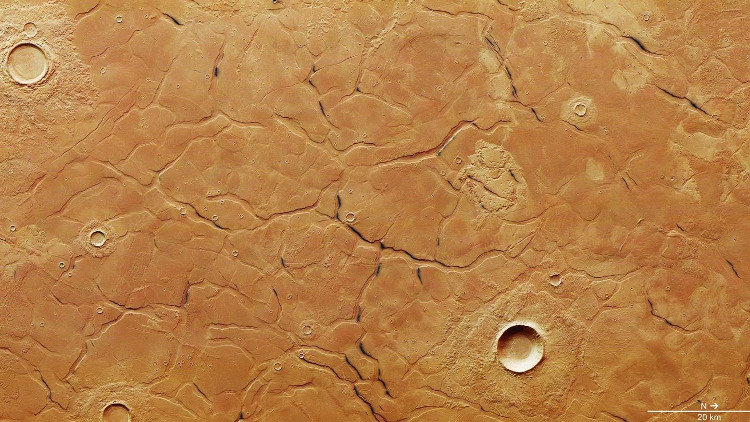The ice sheet on Mars can provide water for future residents
Scientists have found a 170m thick strip of ice, which contains a large amount of water that can be used for residents of Mars in the future.
The team, led by Cassie Stuurman, a Ph.D. student at the University of Texas, discovered a strip of ice on Mars that contained the same amount of water as the Upper Lake, the largest and deepest lake in the Great Lakes in North America third largest in the world, Gizmodo reported today.
After analyzing data from more than 600 ground-penetrating radar scanners on NASA's Mars Reconnaissance Orbiter, scientists showed the existence of a frozen block of water in Utopia Planitia , the plain located in Utopia. , the biggest impact crater on Mars.
Finding ice on Red planet is not a surprise for research experts.

Satellite imagery of topography on Utopia Planitia, where a 170m-thick strip of ice has been found.(Photo: ESA).
"Mars has a lot of frozen water. We think it used to have enough liquid water to cover the entire planet at a thickness of 100 meters. Although most of this water has evaporated into space, today still has a large amount of water accumulates at the poles on Mars, " Stuurman said.
However, it is worth noting that Utopia Planitia is about 50-85% of freezing water compared to stone material. Utopia Planitia dressings mainly exist in individual blocks, not in rock masses. The entire ribbon has a thickness of up to 170m.
"No such thick mass of ice has been discovered. It may contain data on the climate patterns in it, " Stuurman said.
In other words, thick ice can give us a closer look at the history of climate on Mars.
In addition, this water source can also be used for humans. The ribbon stretches near the equator, which is considered to be the most friendly environment in the planet's "warming period" . It is located on a flat terrain, suitable for moving by specialized vehicles. In addition, the ice block is also located near the surface, covered by the Martian weathering layer 1-10m thick.
"This water is more accessible than most other icy waters on Mars," said Jack Holt, of the University of Texas, co-author of the study.
Stuurman is continuing to pair the details of the region's geological history. It is said to accumulate water from the snow during the ice age, when the planet tilted along its axis more than today. Understanding Utopia Planitia's formation can help scientists detect many other similar water bodies.
- Risks face when living on Mars
- Latest Mars map
- Space nuclear reactors help to colonize Mars
- Project to build a water collection farm on Mars
- There was drinking water on Mars
- Water flows on Mars - the discovery changes the cosmic perception
- The photos prove there is water flowing on Mars
- NASA confirmed that there was water flowing on Mars
- Detects significant amount of water in the soil on Mars
- Future model on Mars in the future
- Did the ocean on Mars get into the rock?
- 1,058 candidates are recruited as Martian residents
 Van Allen's belt and evidence that the Apollo 11 mission to the Moon was myth
Van Allen's belt and evidence that the Apollo 11 mission to the Moon was myth The levels of civilization in the universe (Kardashev scale)
The levels of civilization in the universe (Kardashev scale) Today Mars, the sun and the Earth are aligned
Today Mars, the sun and the Earth are aligned The Amazon owner announced a secret plan to build a space base for thousands of people
The Amazon owner announced a secret plan to build a space base for thousands of people